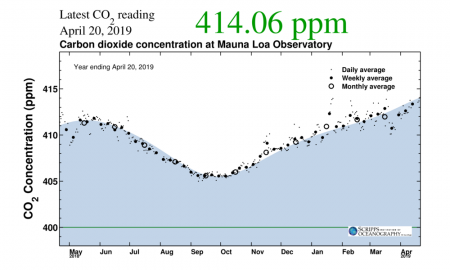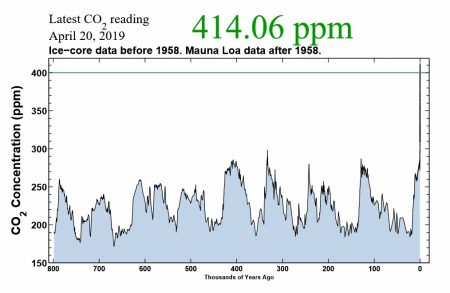April 22, 2019 – Just in case you are keeping score, the latest atmospheric carbon dioxide (CO2) readings from the observatory atop Mauna Loa in Hawaii indicates 414.06 parts per million (ppm). That compares to 310.99 ppm in 1949, the year I was born. That’s an increase of 33% in 70 years.
When asked by reporters about the results being linked to human activity, the researchers at the Scripps Institute answered:
“The rise in CO2 is unambiguously caused by human activity, principally fossil-fuel burning. This is clear from the numbers: We know how much fossil fuel is converted into CO2 each year and emitted into the atmosphere. The CO2 doesn’t all stay there because some enters the ocean and some is taken up by photosynthesis, which ends up in land plants and various types of biomatter.
“Carbon atoms are not created or destroyed in any of these processes, so the total fossil-fuel emission to date must equal the combined increases in these other reservoirs. We can document large carbon increases in all these reservoirs. In the atmosphere, it’s especially easy, because the atmosphere is quite well mixed. As it happens, about 57 percent of the emissions have remained in the air.
“It’s true that atmospheric CO2 has almost certainly been higher than present in Earth’s distant past, many millions of years ago. But because fossil-fuel burning is not natural, the recent carbon increases in the atmosphere, oceans, and land biosphere cannot be natural either. And you are correct that even though the levels of CO2 in the air may not be unprecedented, the pace of rise probably is. Few if any natural processes can release fossil carbon into the atmosphere as fast as we humans are doing it now via the extraction and burning of fossil fuels.”
And if we reconstruct atmospheric CO2 levels going back 800,000 years (we can do this by sampling gases in ice cores taken from alpine and continental glaciers) then we see that at no point in recent history has CO2 increased so dramatically as it has since 1950.
Through interglacial periods, CO2 levels have fluctuated from below 200 ppm to nearly 300. These variances have happened over thousands and tens of thousands of years.
Now look to the right end of the graph and see how the tracing suddenly goes almost vertical. That’s representative of our modern industrial society and correlates with the burning of carbon-based fuels since the Industrial Revolution in the 19th century and its spread from Europe and North America to the rest of the planet. The curve also matches the growth in Earth’s human population.
No occurrence in nature can account for this sudden rise. There have been no sudden methane or CO2 burps from the ocean depths or any massive greenhouse gas releases from melting permafrost. There has been no bombardment of the Earth by a celestial source bringing these gases to the atmosphere during this period of recorded history. All there is just us humans burning coal, oil, gasoline, diesel, and natural gas, and at the same time increasing our population by more than 700% in just over a century.










